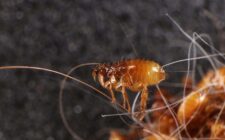Seeing a cockroach roam across your kitchen floor is never a happy sight, but homeowners in the Midwest are getting more of these unwanted houseguests than ever before. Chicago apartments, Kansas City homes, and residents across Illinois, Missouri, Iowa, Wisconsin, and nearby states say they see cockroach populations that double or triple overnight.
With the weather patterns clamouring and warm temperatures hitting cities like no other, these pesky survivalists found the perfect conditions to breed all the way across the region. While it is easy to get rid of a few cockroaches, if there is a continuous problem and you are unable to get rid of cockroaches no matter how much you do, you need to get the best pest eliminators for the safety and happiness of your family.
Are Cockroaches Increasing In Midwest States?
Yes, cockroach populations really are on the rise in Midwest states, and the statistics are pretty alarming. According to the 2019 American Housing Survey, approximately 14 million occupied housing units had seen roaches and 14.8 million rodents in the past 12 months.
According to local pest control experts, the problem is terrible in July and August when property owners in Des Moines, Kansas City & across the Midwest are likely to see more roaches this summer. And this increase is not coincidental; it represents wider environmental and population changes in the region. To make matters worse, 39% of Americans found cockroaches to be the least favorite pest of all, compared to 37% for spiders, 29% for ants, and home-destroying termites at 28%.
Reasons For the Cockroach Increase In the Midwest
The explosion of cockroach populations across Midwest states is the result of several entangled but related forces that have come together to create perfect storm conditions for the pest.
1. Climate Change and Temperature Fluctuations
The reproductive cycle of cockroaches has sped up with increased temperatures across the Midwest. Warmer weather means the metabolic cycles of pests speed up, something we have seen exceptionally well in the Germanic cockroach that resides in many houses in the region.
2. Urban Development and Housing Density
In cities like Chicago, it can be urban sprawl that gives the cockroaches all they can ever want: hiding spots, breeding spots, and entry points to our homes! With so many places to hide and easy entry points, Cockroaches find themselves at home before you know it in the urban landscape of our city.
3. Seasonal Migration Patterns
American cockroaches will head back inside if there is a food shortage or due to dramatic climate change. Cockroach season begins when temperatures heat back up. Many of these that have been lying dormant for the winter will spring out for food sources and reproduce, causing sudden infestations that take homeowners by surprise.
4. Food Availability and Waste Management
Cockroaches are well fed in densely populated urban centers, dishing out copious amounts of food waste. Midwest cities are full of restaurant districts and food processing facilities, which create constant sources of food for the cockroaches and large populations that can survive year-round.
5. Moisture and Humidity Levels
The region’s hot, wet summers and moist springs provide the perfect environment for cockroaches to thrive. Flooded basements, a common occurrence across numerous Midwestern states, offer these pests the humid climate ideal for nesting.
What Are Residents Doing About It?
Some Midwest residents try home remedies, while others call pest control as cockroach numbers rise. Often, homeowners will first buy sprays and baits you can get at a store, but these temporary remedies usually do not address the reason for the problem.
However, the best course of action is working with Midwestern professional pest control experts who are familiar with the challenges presented by local cockroach infestations. Regional pest control companies, like Reliable Pest Solutions, have seen surges in service calls, particularly in spring and summer when many cockroach species are most active. Successful treatment, they say, is through thorough inspection, targeted treatment of breeding sites, and follow-up inspections to confirm that the pests have not returned.




